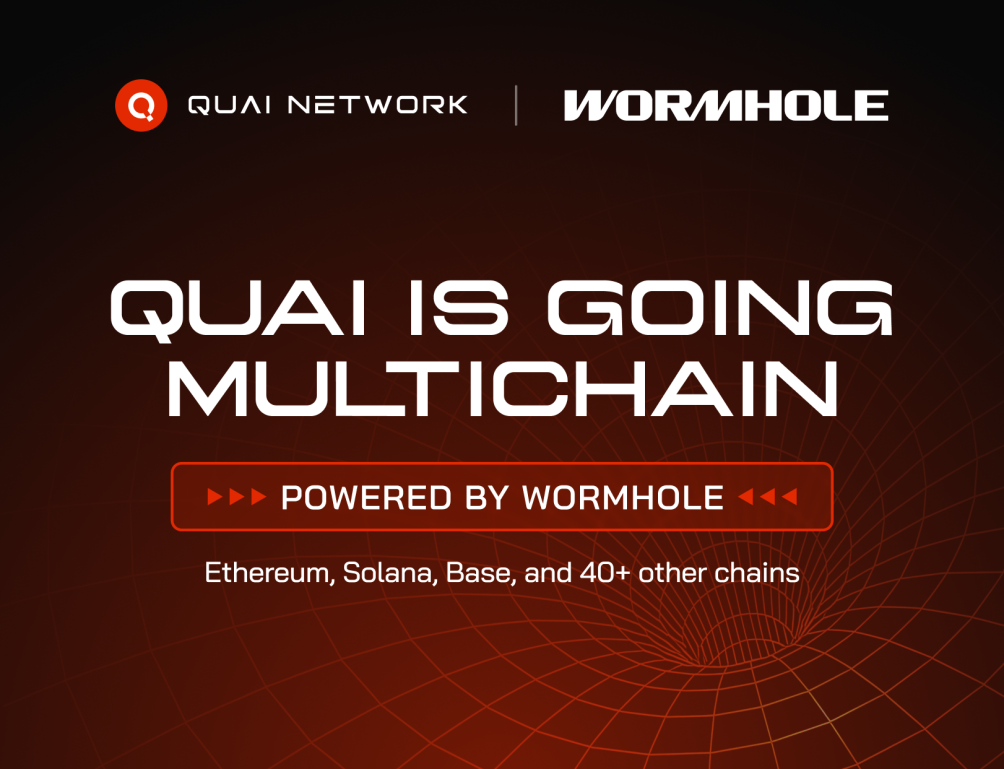
Today, we’re announcing that Quai Network is integrating with Wormhole. Quai will leverage Wormhole’s core messaging layer to enable seamless asset transfers from over 40 blockchains to our scalable Proof-of-Work ecosystem. Quai is also taking $QI and $QUAI multichain using Wormhole’s NTT (Native Token Transfers) standard. Let’s dive into what this means for you, our users, developers, and the broader crypto space.
What is Quai
Quai is the world’s first energy-based monetary system.
The network consists of sharded EVM-compatible blockchains that deliver 255,000 TPS without sacrificing decentralization, all powered by our innovative Proof-of-Entropy-Minima (PoEM) consensus. With $QUAI as our native token and $QI as the decentralized energy dollar, we’re creating a stable, low-fee environment for payments, DeFi, SocialFi, NFTs, and more.
We’ve had an action-packed 2025 so far, and have been full throttle since launching mainnet. From community events like our weekly Quai Nation catchups and Founders Fireside Chats, to top-tier integrations like this one: our node map is lighting up globally, and apps like Kipper and BlipPay are making crypto payments IRL a reality.
What is Wormhole NTT
Wormhole NTT (Native Token Transfers) is an open and composable standard for enabling seamless, secure, and efficient movement of tokens across over 40 blockchain networks. NTT allows for native token transfers without liquidity pools, preserving token properties like metadata and supply across chains while minimizing fees and complexity. It’s designed for high-scale applications, supporting custom token standards and governance, and has powered billions in multichain volume for leading projects.
What This Integration Means for Quai
Through this integration, Quai Network is building on top of Wormhole NTT and messaging protocols. This opens up Quai to the wider blockchain universe, allowing $QUAI and $QI to be natively deployed to major chains like Ethereum, Solana, Binance Smart Chain, Base, Avalanche and more – effortlessly.
Here’s what we’re rolling out first:
- Native Token Transfers: Move your tokens across chains without the hassle of wrapped assets or high fees.
- Multichain dApps: Developers can build applications that tap into Quai’s high throughput while accessingwith liquidity and users from other ecosystems.
- Enhanced Access to Liquidity: By connecting to Wormhole’s vast network, we’re boosting access to liquidity for $QUAI and $QI, making it easier for new users to join the energy dollar economy.
This makes Quai Network more accessible and practical for everyday use, from tipping creators on X via Kipper to unlocking the power of $QI in DeFi to global payments backed by energy.
Looking Ahead: What’s Next?
Stay tuned for the integration to go live – we’ll be announcing the official launch date and providing step-by-step guidance to help you get the most out of Quai’s new multichain capabilities.
In the coming months, expect tutorials on using Wormhole for transfers, developer grants for multichain projects on Quai, and a growing number of ecosystem projects leveraging this integration.
If you’re a builder, head to our docs at docs.qu.ai to get started with the Wormhole SDK on Quai. Users, keep an eye on our X (@QuaiNetwork) for live demos and community events to celebrate the launch.
About Quai
Quai Network is the world’s first energy-based monetary system built on a scalable Proof-of-Work blockchain. The network features dual native tokens – $QUAI as a programmable store of value and $QI as a decentralized energy dollar – enabling both smart contract functionality and stable digital cash transactions. Powered by the breakthrough Proof-of-Entropy-Minima (PoEM) consensus mechanism and horizontal sharding architecture, Quai delivers 255,000+ transactions per second while maintaining decentralization.
Since launching mainnet in 2025, Quai has powered applications like Kipper for social payments and BlipPay for real-world crypto transactions. Through partnerships with decentralized computing networks like IO.Net and Akash, users can join tens of thousands of other miners worldwide to mine $QUAI and participate in true decentralization. To learn more about Quai, follow on X, join the Discord, or read more on the blog.
About Wormhole
Wormhole is the leading interoperability platform that powers multichain applications and bridges at scale. Wormhole provides developers access to liquidity and users on over 40 of the leading blockchain networks, enabling use cases that span DeFi, NFTs, governance, and more.
The wider Wormhole network is trusted and used by teams like Circle and Uniswap. To date, the platform has facilitated the transfer of over 60 billion dollars through over 1 billion cross-chain messages. To learn more about Wormhole, follow on X, join the Discord, or read more on the blog.
